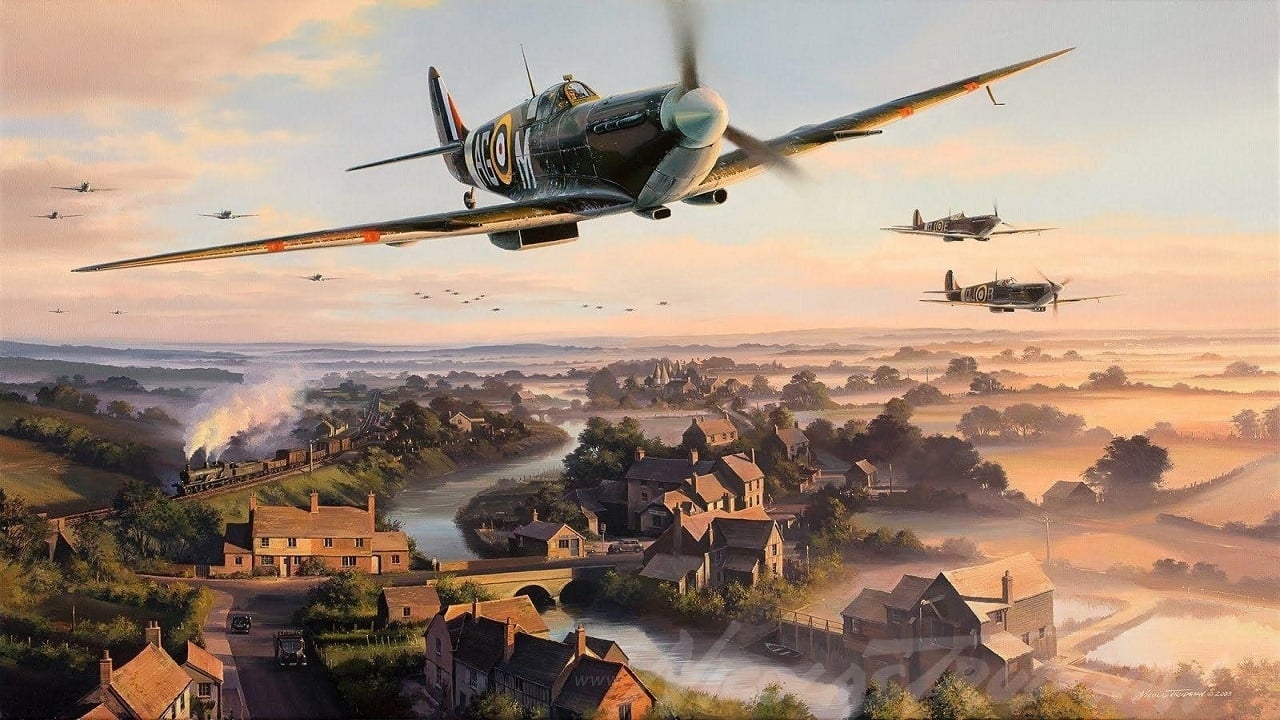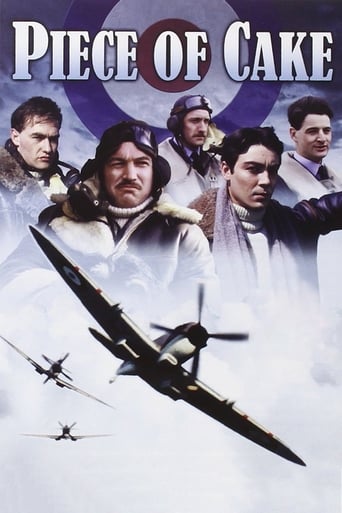

Am I Missing Something?
... View MoreA Disappointing Continuation
... View MoreIf the ambition is to provide two hours of instantly forgettable, popcorn-munching escapism, it succeeds.
... View MoreThe first must-see film of the year.
... View MoreA miniseries adaption of Derek Robinson's book.This is a work of fiction set against a historical timeline and so for the purists - you are going to hate the Sptifires in France (in the real war it was Hurricanes) and the wrong marks of Spitfires and Messerschmits used on the set - so set that aside before you even view this. For this 1988 production the special effects are pretty good and rather show up the sometimes overused clips taken from the 1969 Battle of Britain movie. But set that aside too because.....What elevates this mini series are two key components:The first - for Spitfire enthusiasts - are some of the flying sequences shot for this series. The pilots really had a good time and showed off their skills with some flair. Camera angles and careful lens selection can make a Spitfire look like it is flying among tree tops when the trees are in reality some distance from wings but you can's deny just how close to the ground some of these planes really are. When they fly in formation at a camera at almost zero feet you can see the planes bouncing around in each other's turbulence and ground effect and the pilots correcting and jinking to stay in formation. It is as close to being IN an airborne Spitfire as I am ever likely to get. There are also some wonderful shots of planes making the curved landing approaches required by Spitfires' long noses that you could not see over. Tail shots of three point tail dragger landings are quite spectacular too. Watch those unlocked tail wheels spin in the initial shock!The second key part of this production - for those looking for the story - are the characters developing against the timeline and changing as the pressures of battle alter them all in different ways. Recent post war research has shown that the real make up of the RAF during the Battle of Britain had little to do with Univesity educated upper class so often portrayed. So this view is maybe closer to the pre-war squadron portrayed here - at least at the start of the series.Important crunch issues of:the difficulties of aircraft recognition, - outdated tactics on the British side, - friendly fire in battle, - how horribly people really died in their planes when hit, - how you could be just plain unlucky if your plane faltered in the heat of the moment - and just how hard it was for the RAF pilots to learn and pass on experience as they often failed to make it home to tellall make a showing as "Hornet Squadron" falls back from France to literally sit on the edge of the White Cliffs of Dover in the front line of those trying to fend off the marauding Luftwaffe.For the less well developed characters there is a horrific reality - they never survived long enough to get into the story because they get shot down as soon as they appeared.What sets this series aside - especially from big perspective movies like the Battle of Britain - is the close up portrayal of the reality of rapid aircraft and personnel turnover. By the end - the few old timers are "twitching" with stress and falling as they make mistakes or their luck runs out. If you have ever read the official history of the battle and read the too often used line - "Squadron sent north to rest and re-equip" this series brings home the horrific reality that lay behind that seemingly bland statement. There is absolutely no doubt that in the final moments of the series as the stragglers return - that is where this squadron is headed - what is left of it.A good adaption of the original book and a worthy tribute to "the few".---------Available on DVD - the transfer comes in for some criticism - but you can't make better resolution for a DVD out of an older and lower resolution telecine tape. Set aside the slight fuzziness and watch the story.
... View MoreSure they zoomed in on the same bad model explosions from "Battle of Britain" or that the annoying moving shadows on the tight cockpit shots. (mostly overcast) What triumphs is the powerhouse talent and real flavor of events. I watch it regularly,the spit scenes are languorous(?) and beautiful. the fact that the squadron is the main character,allows for characters to come and go (albeit painfully) Its lovingly art directed (This was a matter of national pride) - and directed with a sure hand.I'm sure somebody in here in Hollywood caught this on cable and immediately wanted to make the rumored "The Few" With Tom Cruise. History has to take a bit of a hit to make a memorable movie.
... View MoreI've read several conflicting reports about the accuracy of Derek Robinson's novels. Some veterans claim that the pilots of the RAF never behaved in such a loutish manner, while others say that "Piece of Cake" is closer to the truth than most people would like to admit. Robinson researches all his books, and states that everything in them actually did happen at some point, and that he only dramatized reality by putting all the characters and events into one story. Characters like the cad Moggy Cattermole, the unbalanced Flash Gordon, or the abjectly terrified Pip Patterson are the same kind of people you'd find in an English public school -- just like the real pilots of the Royal Air Force. Robinson's artistic license places them all in the same squadron, but I don't doubt that men like them did exist in the war.The behavior of Hornet Squadron's pilots on the ground does not diminish their heroism in the air; the fact that they held off the Luftwaffe is proof enough that they deserve our respect, regardless of what they were like in person. The flawed humanity of its characters makes the sacrifice of the real pilots much easier to understand than if they were portrayed simply as selfless heroes, even if we would be more comfortable remembering them that way.The flying scenes in this series are definitely above average and should be enough to recommend it to aviation enthusiasts. A few clips here and there come from 1969's "Battle of Britain", but for the most part the scenes of Spitfires taking off and landing or flying in formation are all brand-new, including some low-level stunts involving bridges. These were real stunts performed by a real pilot -- they found the longest single-span stone bridge in the country, and flew a real Spitfire under it. It's a hell of a scene.Apart from all that, the series is very well done. The acting is great all round, particularly Neil Dudgeon as Cattermole and Richard Hope as Skelton. The script is funny and extremely quotable. After the squadron adjutant reads Churchill's speech out loud -- "Never was so much owed by so many to so few" -- one pilot asks, "Does that mean we can go home now?"
... View MoreForgiving the various historical inaccuracies (Spitfires instead of Hurricanes, aircraft colour schemes, etc) this is a very enjoyable piece of TV.Though it may be hard to choose one truly great character in the programme, as there are so many, I really have to admire 'Moggy' Cattermole. Moggy gets the best lines, without a doubt, and he is undeniably the one we'd all want to be. Unbelievably charming, absolutely dashing and the definition of wit itself, Moggy steals the show on the ground. But it is the aerial content that I wanted to watch in this - the fight scenes are well done, and the way in which the whole thing is brought together (well explained in a very informative and thought provoking book, 'How They Made.....') is quite remarkable.Throughly enjoyed over and over on video, too.
... View More